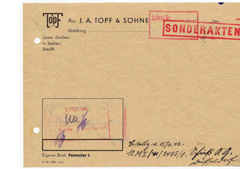
To prove Hoaxoco$t, simply save, print out, and fill in with old typewriter.
Example: "Dear Sir, We hereby acknowlege your order 1 x gas chamber for extermination purposes." Click here to enlarge.
The above document supposedly bears Kirschenek's signature at the top. The following document also supposedly bears Kirschenek's signature, too, at the bottom.
This discussion is far easier to follow if you actually have Pressac's
book. Pressac reproduces these different signatures without noticing that
they are different.
Here's another Kirschenek, above, and another below.

"Abschrift" means "copy". These documents are all "photocopies" of "microfilm copies" of Soviet or unknown origin; the existence and whereabouts of the originals is unknown; their authenticity remains unproven. The first document is apparently an "original" of the second, which is probably a "carbon"; but both are copies. Both have been signed by Pollok, while the second only has been signed by Kirscheneck. One of the problems with these documents is that J.C.-Pressac reproduces at least 3 different signatures for Kirscheneck, and probably 4 or 5 for Pollok; we have reproduced only a few of them here. Considering the ease with which photocopies can be falsified, and in view of the fact that the original documents are not available, one should be far more sceptical than is usually the case.
![]()



Remember, these are all supposed to be various signatures of the same person. After the assassination of President Kennedy, the KGB forged a letter from Lee Harvey Oswald in which the handwriting was almost perfect (they patched it together from real letters actually written by Oswald) but they misspelled his middle name. That, too, was a "photocopy" of a "microfilm".
http://mcadams.posc.mu.edu/bogus.htm
See also:
The Unreliability of Documents used by Jean-Claude Pressac by C. W. Porter
Graphic of Document BW/30/42
Commentary on Document L-180 ("Einsatzgruppen Report") by C.W. Porter
The following are a couple of signatures from "Jothann":


And now for a couple of signatures from "Pollak":

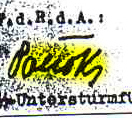
Are these two signatures by the same person? To me, the first looks like a natural signature; the second one looks like a long, slow, crude tracing job using a flat, round nib (used by artists to achieve a uniform line, or, in this case, to disguise the direction and pressure of the strokes ).
Compare, in particular, the "tail" on the "k". The strokes do not appear to start and stop in the same places, or with the same amount of pressure. Instead, the lines are uniformly curved and rounded, like a neon sign.
Apart from its use in this document, "Vergasungskeller" appears to be a totally non-existent word in German. It has no known technical meaning; it is not listed in any technical dictionary that anyone appears to know of, either on-line or in book form, for example, the Eurodicautom or http://www2.dict.cc (they even have a forum). The "Vergasungkeller" document is apparently the world's first, last and only use of this term, anywhere, ever. If anyone can prove the contrary, please contact me.
My personal theory is that the document was forged by a Soviet with a deficient knowledge of the German language and who thought that "Vergasungskeller" meant "gas chamber". The funny thing is that "Gaskammer" was, and is, a perfectly normal German word! Why didn't they say "gas chamber" if that was what they meant? It's all over their blueprints (meaning, of course, "disinfestation gas chamber").
Even Pressac admits this. The REAL "gas chambers", according to him, are labelled LEICHENKELLER, i.e., morgue.
And if they really meant "carburation chamber" (a revisionist theory), then why didn't they write "VergasungsKAMMER" instead of "KELLER"? Then they would have a real word.
For a similar botch job, and examples of several others, see:
Graphics of 1650-PS "Bullet Order" ("German" document with English-language stamps)
-----------
And now for a few signatures by "Bischoff". Are all 6 of these the signatures of one and the same person? I do not even believe that signatures 5 and 6 are by one and the same person. Signatures 2, 3 and 4 are probably authentic, 3 and 4 certainly so. In my view, signatures 1, 5 and 6 are forgeries, or someone else signing on Bischoff's behalf; but in the latter case, the document should then state ("Im Auftrag", or some such similar phrase above the signature). This may be the meaning of the "gez." ("signed") before signatures 5 and 6, in which case the signatures might well be of some more or less unknown person (or two more or less unknown persons), but not a "forgery".
In that case, it would simply mean that Bischoff allegedly signed the "original" document, after which somebody "else" came along, "copied" the document, wrote "signed Bischoff", in his OWN handwriting (something I've never seen before and which I do not believe) -- without indicating his own name, which I cannot imagine in any office system -- after which the "original" got "lost", a "photocopy" or "microfilm" was then made of the "copy", and the "signature" is simply another step backwards in the infinite regress of "copies" of "copies".
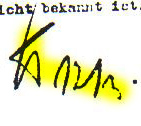

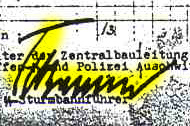
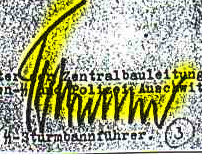
![]()

The point, as always, is that there are no original documents supporting the Hoaxoco$t thesis and many of the documents we have are obviously suspicious. All we have is this kind of garbage.
Or, in Pressac's words:
"The Soviet Union... trapped by memories of a guilty past (Katyn, the Gulags), and by an equally guilty present, discredited itself in the eyes of the world... " (TECHNIQUE, etc. p. 264.)
CARLOS W. PORTER
REVISED JUNE 15 2005